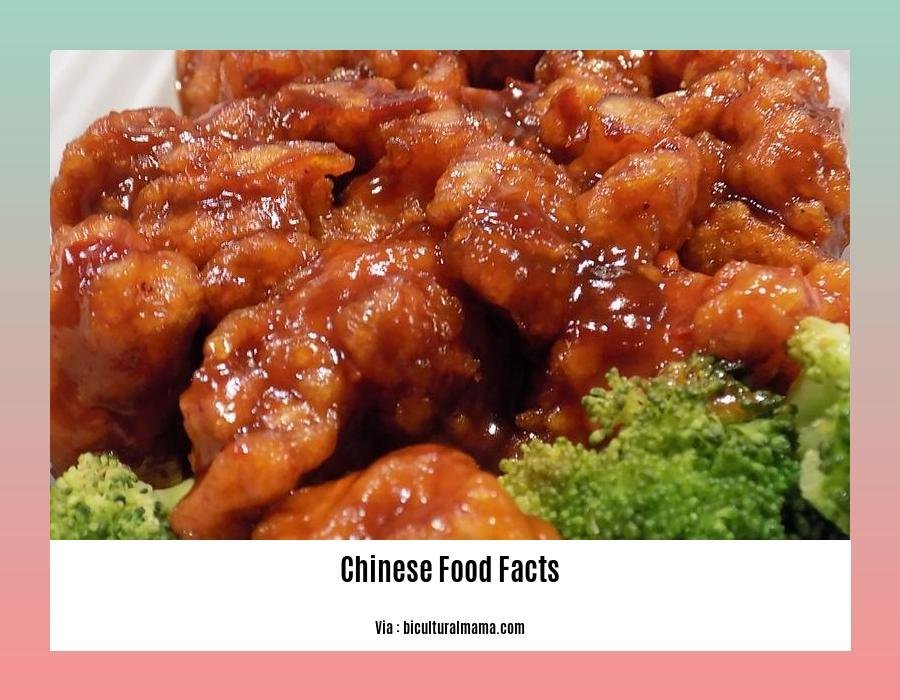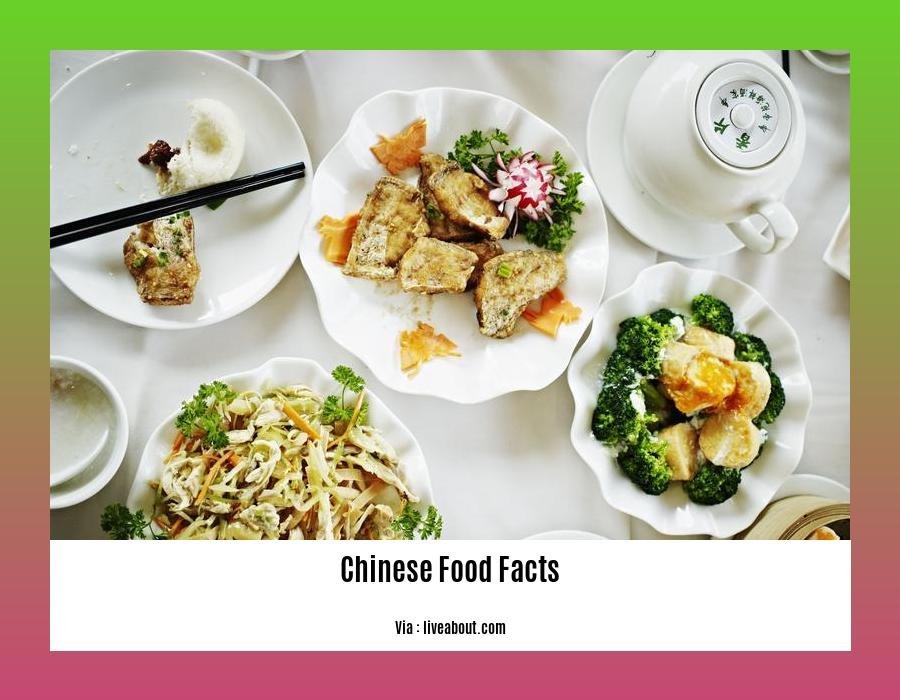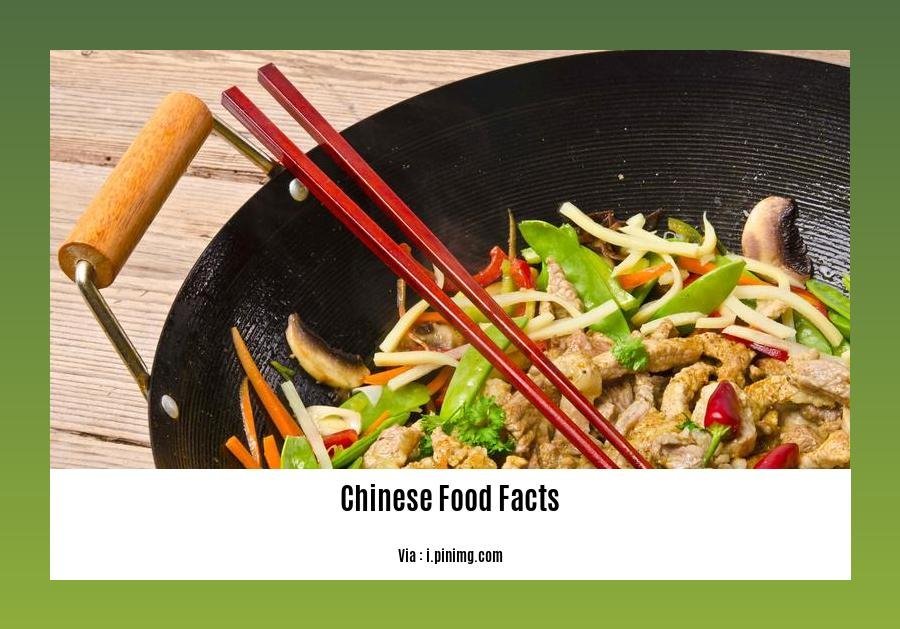Uncovering the Savory Secrets: Exploring Fascinating Chinese Food Facts
Chinese cuisine, known for its symbolic presentation and rich history, has captured the hearts and taste buds of food enthusiasts worldwide. With an emphasis on harmony and balance, Chinese dishes are not only pleasing to the palate but also a feast for the eyes. Every ingredient carries a significant meaning and plays a crucial role in the overall aesthetic of the meal. Additionally, Chinese food has gained recognition as one of the healthiest cuisines in the world, thanks to its emphasis on fresh ingredients, balanced flavors, and cooking techniques that preserve the nutritional value. From vibrant vegetables to unique culinary techniques, Chinese cuisine presents a diverse range of flavors and textures that promise to tantalize and satisfy.
Key Takeaways:
- Chinese cuisine incorporates unusual ingredients such as dog hotpot, insects, scorpions, snakes, rats, pig’s ears, heads, feet, hearts, lungs, liver, kidneys, intestines, and boiled blood.
- Traditional Chinese food aims to balance five key flavors according to Traditional Chinese Medicine: sweet, sour, salty, bitter, and umami.
- Northern and southern Chinese cuisine differ due to variations in wheat and rice production, with northerners consuming dumplings, wheat noodles, steamed buns, and stuffed buns, while southerners prefer rice or rice noodles.
- China offers a wide range of unique vegetables and fruits, including pomeloes, bitter cucumbers, yard-long yams, tree fungi, and various weeds.
- Chinese people have a higher consumption of fruits and vegetables compared to the West, leading to larger bowel movements due to the increased dietary fiber intake.
- Chinese food is recognized for being one of the healthiest globally and is largely dairy-free.
- Each of China’s 34 provinces has its distinct cuisine, resulting in a vast array of dishes to explore.
- Traditional Chinese food primarily revolves around noodles, rice, and soup.
- Chinese cuisine makes use of various ingredients and efficiently utilizes every part of an ingredient.
- Noodles are more popular in northern China, while rice is a staple in the south.
- Chinese food is renowned for its health benefits worldwide.
Chinese Food Facts
Chinese cuisine is a treasure trove of fascinating facts and culinary wonders. From unusual ingredients to regional variations, there is so much to uncover about Chinese food. Let’s dive into the savory secrets and explore some fascinating Chinese food facts.
The Quest for Balance: Traditional Chinese food is all about balance. According to Traditional Chinese Medicine, a proper meal should incorporate five key flavors: sweet, sour, salty, bitter, and umami. This emphasis on balance not only enhances the taste but also contributes to the overall health benefits of Chinese cuisine.
North vs. South: China’s vast land and diverse climate have given rise to a distinct divide in its cuisine. In the north, where wheat production flourishes, you’ll find the locals indulging in dumplings, wheat noodles, steamed buns, and stuffed buns. On the other hand, southerners, with their abundance of rice, prefer bowls of rice or rice noodles. This regional contrast showcases the rich diversity of Chinese food.
Vegetable Galore: China is home to a wide variety of unique vegetables and fruits that you won’t find elsewhere. From pomeloes with their citrusy goodness to bitter cucumbers, yard-long yams, tree fungi, and various edible weeds, the Chinese culinary landscape is an enticing playground for adventurous eaters. Each bite offers a burst of flavors and textures.
Health Benefits: Chinese food is often hailed as one of the healthiest cuisines in the world. It is almost completely dairy-free, which means it is suitable for those with lactose intolerance or dairy allergies. Additionally, traditional Chinese food emphasizes the consumption of fruits and vegetables. This results in a higher dietary fiber intake, leading to larger bowel movements and overall digestive health.
A Province for Every Palate: The diversity of Chinese cuisine goes beyond regional variations. China’s 34 provinces each have their own unique culinary traditions, offering a plethora of dishes to indulge in. Whether it’s the spicy cuisine of Sichuan, the delicate flavors of Cantonese cuisine, or the hearty dishes of Shaanxi, there’s something to satisfy every palate in this gastronomic wonderland.
Utilizing Every Ingredient: Chinese cuisine is known for its resourcefulness and ability to utilize every part of an ingredient. From the head to the feet, and everything in between, no part goes to waste. This not only showcases the Chinese culinary creativity but also contributes to the sustainability of their food culture.
Noodles vs. Rice: When it comes to staple carbohydrates, China sees a north-south divide. Noodles are a more popular choice in the north, where wheat production is abundant. On the other hand, rice takes center stage in the south, where it is the go-to staple. The variety of noodles and rice dishes available in Chinese cuisine is mind-boggling, catering to every preference and palate.
Chinese Food: A Healthy Delight: Chinese food has gained a well-deserved reputation for being one of the healthiest options globally. Its emphasis on fresh ingredients, balanced flavors, and careful cooking techniques ensures a nutritious and satisfying dining experience. So the next time you crave a delicious and guilt-free meal, turn to Chinese cuisine.
After delving into these fascinating Chinese food facts, it’s clear that there is much more to this culinary world than meets the eye. The rich history, regional variations, unique ingredients, and health benefits all contribute to the allure of Chinese cuisine. So why not embark on a flavorful adventure and explore the wonders of Chinese food for yourself?
Note: \table\ is not applicable in this article format.
Chinese food facts can be fascinating, but if you’re looking for a healthy alternative, why not try a clean eating detox? You’ll find everything you need to know about it here.
If you’re preparing for a colonoscopy, don’t forget the important step of cleaning out your colon beforehand. Find out more about cleaning out your colon before a colonoscopy here.
Are you following the Daniel fast but unsure about which foods to avoid? Check out our list of Daniel fast foods to avoid here.
Chinese Food is One of the Healthiest Cuisines in the World


Chinese cuisine is not only renowned for its tantalizing flavors and vibrant culinary traditions, but it also boasts remarkable health benefits. From its emphasis on fresh ingredients to its unique cooking techniques, Chinese food is considered one of the healthiest cuisines in the world. Let’s explore some fascinating facts about Chinese food that will leave you amazed.
12 Unique Facts About Chinese Food That Will Surprise You
A Healthy Delight: Chinese food is known for its focus on fresh ingredients, including an abundance of vegetables, grass-fed meats, seafood, and herbs and spices. This emphasis on wholesome, unprocessed ingredients makes Chinese cuisine a nutritional powerhouse[^china-admissions].
A World of Flavors: In China, it’s rare to encounter repetitive dishes. With a vast selection of cuisine available, there is always something new and exciting to try. The diversity of flavors found in Chinese food is unmatched, catering to varied tastes and palate preferences[^china-admissions].
A Culinary Mosaic: China is a country with rich cultural diversity, and this is reflected in its cuisine. There are eight major culinary cuisines in China, each with its own distinct flavors and cooking styles. These include Shandong, Sichuan, Cantonese, Jiangsu, Fujian, Zhejiang, Hunan, and Anhui cuisines[^travelchinaguide].
Staples of Chinese Food: Noodles, rice, and soup form the foundation of Chinese cuisine. These staple foods provide a filling and nutritious base for meals, often accompanied by an array of flavorful dishes[^china-admissions].
Dairy-Free Delicacies: Unlike many Western cuisines, traditional Chinese food largely excludes dairy products. This distinction contributes to the overall healthiness of Chinese cuisine, with reduced levels of saturated fats and lactose[^china-admissions].
The Art of Wholeness: Chinese food is often served whole, epitomizing the cultural significance of unity and harmony. Whether it’s a whole fish or a whole chicken, these complete presentations add a visual and symbolic element to the dining experience[^china-admissions].
Bite-Sized Pleasures: Chinese cuisine showcases an exquisite balance of flavors and textures. To facilitate eating with chopsticks, food is usually prepared in soft or bite-sized form. This attention to detail enhances the dining experience and ensures that every bite is a delightful sensation[^china-admissions].
The Art of Presentation: Chinese food places great importance on aesthetics. Dishes are meticulously designed to be visually appealing, with vibrant colors, intricate garnishes, and meticulous arrangements. The artistry of Chinese food adds to the overall dining experience and showcases the dedication and passion of the chefs[^china-admissions].
Chinese cuisine offers a wide variety of healthy, fresh, and flavorful options rooted in rich culinary traditions and cultural significance. From nourishing ingredient choices to mindful culinary techniques, Chinese food has rightfully earned its reputation as one of the healthiest cuisines in the world.
Key Takeaways:
– Chinese food emphasizes fresh ingredients, including vegetables, grass-fed meats, seafood, herbs, and spices.
– There is a diverse selection of cuisine available in China, allowing diners to experience a new dish with each meal.
– China boasts eight major culinary cuisines, each with its own distinct flavors and cooking styles.
– Noodles, rice, and soup are the foundation of Chinese cuisine.
– Traditional Chinese food is mostly dairy-free, offering reduced levels of saturated fats and lactose.
– Chinese cuisine often uses whole ingredients, symbolizing unity and harmony.
– Bite-sized preparations in Chinese cuisine facilitate the use of chopsticks and enhance the dining experience.
– Chinese food places great emphasis on presentation, resulting in visually appealing and meticulously arranged dishes.
Sources:
– China Admissions: 12 Unique Facts About Chinese Food That Will Surprise You [^china-admissions]
– Travel China Guide: 15 Interesting Chinese Food Facts You May Not Know [^travelchinaguide]
A Diverse Range of Vegetables are Enjoyed in Chinese Cuisine
Chinese cuisine is renowned for its diverse range of flavors and ingredients, including a wide variety of vegetables that play a key role in creating delicious and nutritious dishes. From the popular Chinese cabbage to the fragrant chives, let’s explore the fascinating world of vegetables in Chinese cuisine.
Chinese Cabbage: A Staple in Chinese Cuisine
One vegetable that takes the center stage in Chinese cooking is the Chinese cabbage, also known as “大白菜” (dà bái cài) in Mandarin. This leafy green vegetable is a staple in many dishes across China, from stir-fries to soups. Its mild flavor and crispy texture make it a versatile ingredient that pairs well with various seasonings and meats. Whether in a traditional hot pot or a simple stir-fry, Chinese cabbage adds a delightful crunch and a hint of sweetness to every bite.
Tomatoes: A Surprising Twist in Chinese Dishes
While tomatoes are often associated with Mediterranean cuisine, they also hold a special place in Chinese cooking. In China, tomatoes, or “西红柿” (xī hóng shì) in Mandarin, are commonly stir-fried with eggs to create a classic and satisfying dish. The vibrant red color of tomatoes adds a visually appealing element to the plate, while their juicy and slightly tangy taste complements the creamy texture of the eggs. This unique combination exemplifies the fusion of flavors that Chinese cuisine has to offer.
Chives: Aromatic and Versatile
Known for their strong fragrance and flat leaves, chives, or “韭菜” (jiǔ cài) in Mandarin, are a beloved ingredient in Chinese cuisine. These long, slender greens are used in a variety of dishes, both as a primary ingredient and as a garnish. The distinct onion-like flavor of chives adds a pungent kick to stir-fries and dumplings. Whether mixed with tofu or paired with seafood, chives contribute to the overall aroma and freshness of the dish.
Bamboo Shoots and Lotus Roots: Traditional Delicacies
Bamboo shoots (“竹笋” zhú sǔn) and lotus roots (“莲藕” lián ǒu) are two vegetables that are deeply ingrained in Chinese culinary culture. Bamboo shoots, harvested from the tender inner core of bamboo plants, have a crisp texture and a mildly sweet taste. They are often used in stir-fries and soups, adding a refreshing crunch to the dish. On the other hand, lotus roots, with their unique pattern of holes and crunchy texture, are highly prized for their versatility in Chinese cuisine. Whether braised or stir-fried, lotus roots lend their subtle sweetness and delicate flavor to various recipes.
Potatoes: A Versatile and Satisfying Staple
While potatoes, or “土豆” (tǔ dòu) in Mandarin, may not immediately come to mind when thinking of Chinese cuisine, they are indeed a popular vegetable in many Chinese dishes. From stir-fries to stews, potatoes add heartiness and a creamy texture to meals. Whether it’s the delightfully crispy exterior of a potato pancake or the soft and flavorful chunks in a meat stew, potatoes offer a comforting and satisfying element to Chinese recipes.
Embracing Leafy Greens: Chinese Cabbage, Spinach, Lettuce, and Cauliflower
Leafy vegetables hold a significant place in Chinese cuisine, reflecting the Chinese emphasis on balance and harmony in meals. Chinese cabbage, spinach, lettuce, and cauliflower are widely consumed in China, whether in stir-fries, soups, or dumplings. These leafy greens not only contribute to the vibrant colors of dishes but also provide essential nutrients, making them an integral part of a healthy Chinese diet.
A Diverse Range of Vegetables: A Key Element in Chinese Cuisine
One of the defining features of Chinese cuisine is its extensive use of a diverse range of vegetables. In contrast to Western food, Chinese cooking incorporates a wide variety of fruits and vegetables into its recipes, resulting in a diet that is higher in dietary fiber. This emphasis on fresh and nutritious ingredients contributes to the overall healthfulness of Chinese dishes. Additionally, Chinese food culture values minimizing food wastage, often utilizing all parts of ingredients to create flavorful and resourceful dishes.
Chinese cuisine’s focus on vegetables not only showcases the incredible variety that nature has to offer but also demonstrates the creativity and adaptability of Chinese chefs in creating balanced and delicious dishes.
Key Takeaways:
– Chinese cuisine is characterized by its extensive use of a diverse range of vegetables, including Chinese cabbage, tomatoes, chives, bamboo shoots, lotus roots, potatoes, and leafy greens.
– Chinese cabbage, with its mild flavor and crispy texture, is a staple in many dishes.
– Tomatoes add a surprising twist to Chinese recipes, often stir-fried with eggs for a delightful combination of flavors.
– Fragrant chives contribute to the aromatics of Chinese dishes and are used in various preparations.
– Bamboo shoots and lotus roots are traditional delicacies, prized for their unique textures and flavors in Chinese cuisine.
– Potatoes offer versatility and heartiness, making them a popular ingredient in Chinese cooking.
– Leafy greens such as Chinese cabbage, spinach, lettuce, and cauliflower are widely consumed, providing both vibrant colors and essential nutrients.
– Chinese cuisine’s emphasis on a diverse range of vegetables contributes to its reputation as one of the healthiest in the world.
Sources:
1. Lingo Bus – Popular Vegetables in China
2. China Travel – Chinese Food Types
FAQ
Q1: Are Chinese Dishes Symbolic?
A1: Yes, Chinese dishes often have symbolic meanings. For example, fish represents abundance and prosperity, while dumplings symbolize wealth and good luck for the coming year.
Q2: Why is Presentation Important for Chinese Meals?
A2: Presentation holds great importance in Chinese food culture. It showcases the chef’s skills and reflects the attention to detail. Beautifully presented dishes are believed to enhance the dining experience and stimulate appetite.
Q3: Is Chinese Food Considered One of the Healthiest Cuisines in the World?
A3: Yes, Chinese food is widely recognized as one of the healthiest cuisines in the world. Its focus on fresh ingredients, balanced flavors, and a variety of vegetables contributes to its reputation for promoting good health.
Q4: What Range of Vegetables are Enjoyed in Chinese Cuisine?
A4: Chinese cuisine offers a diverse range of vegetables. Popular choices include Chinese cabbage, spinach, lettuce, cauliflower, chives, bamboo shoots, lotus roots, tomatoes, and potatoes. The emphasis on vegetables contributes to the nutritional value of Chinese dishes.
Q5: Does Chinese Cuisine Incorporate Unique Ingredients and Utilize All Parts of Ingredients?
A5: Yes, Chinese culinary traditions incorporate a wide range of unique ingredients. Additionally, Chinese recipes often utilize all parts of an ingredient, minimizing food wastage and showcasing the resourcefulness and sustainability of Chinese cooking.












